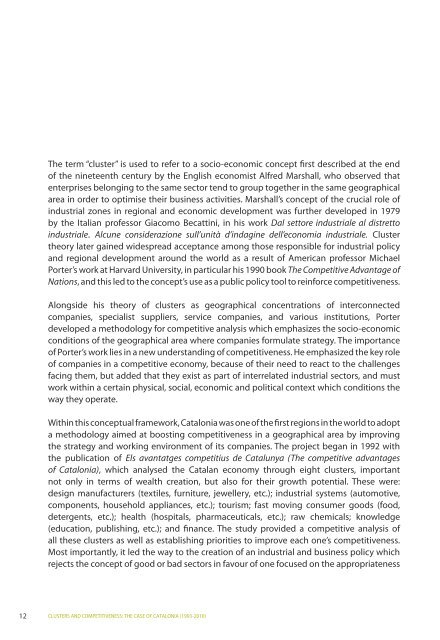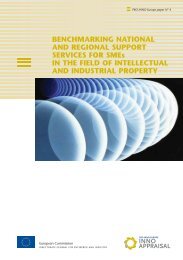Clusters and competitiveness - PRO INNO Europe
Clusters and competitiveness - PRO INNO Europe
Clusters and competitiveness - PRO INNO Europe
You also want an ePaper? Increase the reach of your titles
YUMPU automatically turns print PDFs into web optimized ePapers that Google loves.
The term “cluster” is used to refer to a socio-economic concept first described at the end<br />
of the nineteenth century by the English economist Alfred Marshall, who observed that<br />
enterprises belonging to the same sector tend to group together in the same geographical<br />
area in order to optimise their business activities. Marshall’s concept of the crucial role of<br />
industrial zones in regional <strong>and</strong> economic development was further developed in 1979<br />
by the Italian professor Giacomo Becattini, in his work Dal settore industriale al distretto<br />
industriale. Alcune considerazione sull’unità d’indagine dell’economia industriale. Cluster<br />
theory later gained widespread acceptance among those responsible for industrial policy<br />
<strong>and</strong> regional development around the world as a result of American professor Michael<br />
Porter’s work at Harvard University, in particular his 1990 book The Competitive Advantage of<br />
Nations, <strong>and</strong> this led to the concept’s use as a public policy tool to reinforce <strong>competitiveness</strong>.<br />
Alongside his theory of clusters as geographical concentrations of interconnected<br />
companies, specialist suppliers, service companies, <strong>and</strong> various institutions, Porter<br />
developed a methodology for competitive analysis which emphasizes the socio-economic<br />
conditions of the geographical area where companies formulate strategy. The importance<br />
of Porter’s work lies in a new underst<strong>and</strong>ing of <strong>competitiveness</strong>. He emphasized the key role<br />
of companies in a competitive economy, because of their need to react to the challenges<br />
facing them, but added that they exist as part of interrelated industrial sectors, <strong>and</strong> must<br />
work within a certain physical, social, economic <strong>and</strong> political context which conditions the<br />
way they operate.<br />
Withinthisconceptualframework,Cataloniawasoneofthefirstregionsintheworldtoadopt<br />
a methodology aimed at boosting <strong>competitiveness</strong> in a geographical area by improving<br />
the strategy <strong>and</strong> working environment of its companies. The project began in 1992 with<br />
the publication of Els avantatges competitius de Catalunya (The competitive advantages<br />
of Catalonia), which analysed the Catalan economy through eight clusters, important<br />
not only in terms of wealth creation, but also for their growth potential. These were:<br />
design manufacturers (textiles, furniture, jewellery, etc.); industrial systems (automotive,<br />
components, household appliances, etc.); tourism; fast moving consumer goods (food,<br />
detergents, etc.); health (hospitals, pharmaceuticals, etc.); raw chemicals; knowledge<br />
(education, publishing, etc.); <strong>and</strong> finance. The study provided a competitive analysis of<br />
all these clusters as well as establishing priorities to improve each one’s <strong>competitiveness</strong>.<br />
Most importantly, it led the way to the creation of an industrial <strong>and</strong> business policy which<br />
rejects the concept of good or bad sectors in favour of one focused on the appropriateness<br />
12 CLUSTERS AND COMPETITIVENESS: THE CASE OF CATALONIA (1993-2010)
















